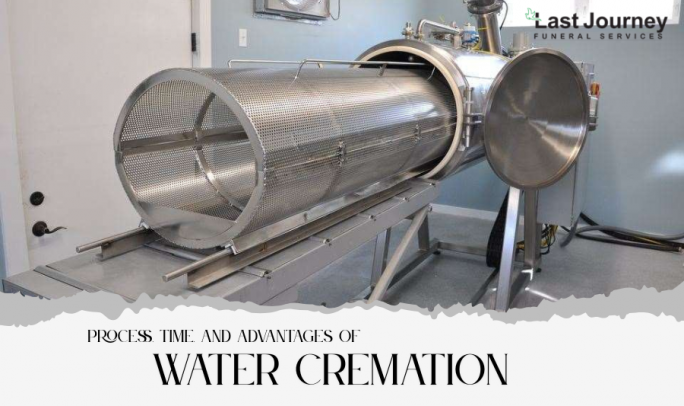Lastjourney Blog
Process, Time, and Advantages of Water Cremation

 Table of Contents
Table of Contents- What is Water Cremation?
- How Does Water Cremation Work?
- How Long Does Water Cremation Take?
- What Happens to the Water After Water Cremation?
- Water Cremation vs Fire Cremation: Key Differences
- Advantages of Water Cremation
- Is Water Cremation Available in India?
- The Future of Sustainable Farewells
As conversations around eco-conscious funerals grow, more families are exploring alternatives to traditional cremation and burial. One such innovation is water cremation, also known as alkaline hydrolysis cremation — an environmentally friendly and gentle process that uses water instead of fire.
In this blog, we’ll explain what water cremation is, how it works, and why it’s considered a greener, more sustainable choice. If you're looking for an alternative to cremation using water, this guide is for you.
What is Water Cremation?
Water cremation is a body disposition process that uses a mix of water and alkali (potassium or sodium hydroxide) to decompose the human body. Scientifically known as alkaline hydrolysis cremation, this method is seen as a modern, eco-friendly alternative to fire-based cremation and traditional burial.
The process mimics the natural decomposition that occurs when a body is buried in the soil, but accelerates it dramatically in a controlled environment.
How Does Water Cremation Work?
Here’s a step-by-step breakdown of how water cremation works:
-
Preparation: The body is placed in a stainless steel pressure chamber (called a hydrolysis unit).
-
Solution Filling: The chamber is filled with 95% water and 5% alkali (usually potassium hydroxide).
-
Heating & Pressure: The solution is heated to around 160–180°C (320–350°F) under high pressure to prevent boiling.
-
Decomposition: Over several hours, the solution breaks down the body tissues, leaving behind only the bone fragments and a sterile liquid.
-
Final Steps:
-
Bone fragments are dried and pulverized into ash (similar to traditional cremation remains).
-
The liquid byproduct is safely drained and treated.
-
This process is also sometimes referred to as "resomation" or "aquamation" in the funeral industry terminology.
Also Read, Procedure to Donate Body After Death in India
How Long Does Water Cremation Take?
While flame cremation usually takes 2–3 hours, alkaline hydrolysis cremation takes around 4 to 6 hours, depending on the body weight, temperature, and equipment used.
Some systems utilize low-temperature (140–160°C) hydrolysis over 12–16 hours, whereas modern high-pressure systems complete the process more quickly.
What Happens to the Water After Water Cremation?
The remaining liquid after the water cremation process is a non-toxic, sterile solution composed mainly of:
-
Water
-
Amino acids
-
Sugars
-
Peptides
-
Salts
This liquid is safe to discharge into the municipal wastewater system or used for biological waste treatment. It contains no DNA, tissue, or harmful chemicals, and is considered environmentally neutral.
In some regions, this water may also be used for fertilization (after appropriate treatment), returning nutrients to the earth.
Water Cremation vs Fire Cremation: Key Differences
| Feature | Water Cremation | Fire Cremation |
|---|---|---|
| Method | Alkaline hydrolysis using water & alkali | Incineration using high-temperature fire |
| Environmental Impact | Low CO₂ emissions, no mercury release | High CO₂ emissions, releases mercury |
| Time Required | 4–16 hours (depending on temperature) | 2–3 hours |
| Remains Returned | Bone ash (soft white powder) | Bone ash (greyish powder) |
| Byproducts | Sterile liquid waste | Airborne emissions, ashes |
| Energy Usage | Significantly lower | Very high (natural gas/fuel-based) |
| Religious Acceptance | Varies; still under discussion | Widely accepted in many cultures |
Water cremation is gaining attention for being more sustainable, especially in regions with environmental restrictions.
Advantages of Water Cremation
-
Eco-Friendly: Up to 90% less energy used compared to flame cremation. No harmful gases or pollutants released.
-
Mercury-Free: No dental amalgam vapor (mercury) is emitted.
-
Gentler Process: Considered more respectful by some, as there is no burning involved.
-
Sterile Outcome: Safe byproducts that do not harm the environment.
-
More Bone Remains: Families often receive more ash volume compared to fire cremation.
Also Read, Purpose of a Freezer Box in Funeral Services
Is Water Cremation Available in India?
Currently, water cremation is not widely available in India, as it is still in early stages of acceptance and regulation. However, several countries, including the US, Canada, Australia, South Africa, and parts of Europe, have legalized and adopted this process in certified funeral homes.
Given the growing conversation around sustainable funeral options, it is expected that water cremation will gradually enter India’s urban and eco-conscious funeral services landscape.
The Future of Sustainable Farewells
As people become more environmentally aware, green funeral practices like water cremation offer a dignified and sustainable way to say goodbye. It’s an alternative to cremation using water that respects both the deceased and the planet.
At Last Journey, we are committed to staying informed and helping families understand every option available. We continue to explore partnerships and innovations that can bring eco-conscious alternatives like alkaline hydrolysis to India.
Your email address will not be published. Required fields are marked *












